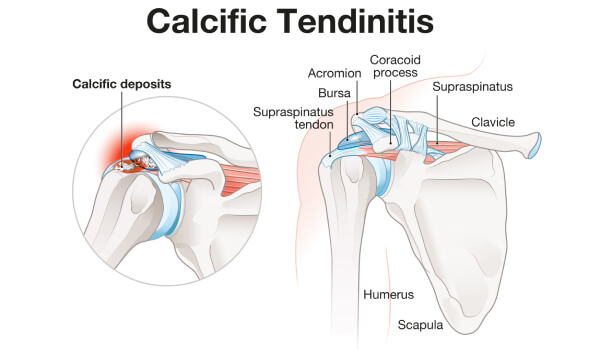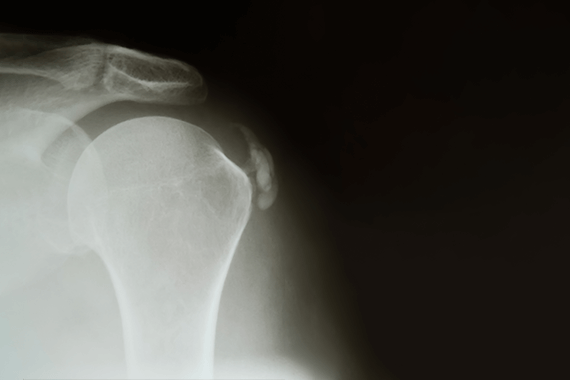Shoulder Calcification
Shoulder Calcification can present suddenly with severe pain in the shoulder or be a chronic condition with several flare ups in the preceding months.
It is one of the most common causes of shoulder pain. Calcific tendonitis or shoulder calcification is a common adult condition but it is also diagnosed in teenagers due to various reasons.
In this article, we will be covering the causes of shoulder calcification, symptoms, its link with other conditions, and potential treatment options.
Shoulder calcification is more prevalent in women than men. It involves people between 40 to 60 years of age. It is rarely noticed in children but sometimes can occur due to multiple reasons.
What Is Shoulder Calcification?
Shoulder calcification occurs when there is excessive deposition of calcium on the tendons of your shoulder. This often occurs due to tendon breakdown due to a variety of factors.
Tendons connect your muscles to your bones. They aid in movement and also protect us from muscle injuries by withstanding high impact. The deposition of calcium around the tissues leads to pain and inflammation, causing a great deal of shoulder pain.
Which Muscle/Tendon is Most Commonly Affected by Shoulder Calcification?
The Supraspinatus tendon in the rotator cuff muscles typically develops calcium deposits. The deposition could be due to various factors like fibrosis, necrosis, systemic, or tendon degeneration. It is estimated that around 7% of shoulder pain or discomfort cases presenting to the doctor involve supraspinatus tendon calcification.
The two kinds of calcific tendonitis of the shoulder are degenerative calcification and reactive calcification. Degenerative calcification is mostly caused by aging-related wear and strain. Whereas the exact cause of Reactive calcific tendonitis is yet to be established. However, it is divided into 3 stages that are:

- Pre calcific: The tendon undergoes modifications that increase the likelihood of calcium deposits forming.
- Calcific: The body simply reabsorbs the calcium deposits that are produced in the tendons during the calcific stage when they start to dissolve. The likelihood of experiencing discomfort is highest at this point.
- Post calcific: The tendon recovers and is “remodeled” with new tissue during the post-calcific stage.
Can Calcific Tendonitis Result In A Torn Rotator Cuff?
What are the Symptoms to Look For?
- Sudden onset of discomfort,
- Severe pain on movement
- The reduced range of motion of the shoulder
- Pain that keeps you awake
Who Is At Risk?
- Postural
- Overuse in certain occupations
- Inflammatory Conditions
- Metabolic illnesses like diabetes and Thyroid issues
How is Shoulder Bursitis different from Shoulder Calcification?
Shoulder Impingement and Shoulder Calcification: What’s the Link?
Is Calcific Tendonitis Common In Children?
Shoulder Calcification or Frozen Shoulder: How to Differentiate?
Adhesive capsulitis, another name for frozen shoulder, is a disorder that causes discomfort and stiffness in the shoulder joint. It is mostly caused by limited movement due to some injury or systemic disease. Typically, signs and symptoms appear gradually, get worse over time, and then go away, usually in one to three years.
Usually, frozen shoulder develops gradually in three stages. Each stage may continue for several months.

Freezing Stage
Your shoulder hurts with every movement, and its range of motion gradually decreases.

Frozen Stage
During this phase, the pain might start to lessen. But as time passes, your shoulder stiffens and is harder to use.

Thawing Stage
Your shoulder’s range of motion starts to get better.
Frozen shoulder and Shoulder Calcification may present very similarly. Indeed, Shoulder Calcification can often lead to Frozen Shoulder. Pain in both conditions can be worse at night and it often disrupts sleep.
An ultrasound scan or an x-ray can diagnose calcification in the shoulder.
How Is Diabetes Responsible For Shoulder Calcification?
According to various studies, diabetes mellitus is one of the leading causes of shoulder calcification. Patients with Diabetes have up to 27% increased risk of developing calcific tendinopathy of the shoulder.
This may be due to the decreased blood flow in the shoulders and insulin deficiency affecting collagen synthesis.
Does Diet Play A Role In Shoulder Calcification?
How Is Shoulder Calcification Diagnosed?

Along with physical examination, symptoms, and medical history, your physician may also order some imaging to confirm shoulder calcification.
These tests include:
- X-ray: plain x-rays display calcium deposits clearly
- Ultrasound: This is highly effective in diagnosing calcification. It also assists in Injections for pain relief or Barbotage procedures to break down the calcifications.
What are the potential treatment options for Shoulder Calcification?
Fortunately, there are certain effective treatment options available for shoulder calcification. The treatments include:
NSAIDs: Most cases of shoulder pain related to shoulder calcification are resolved by NSAIDs (Non-steroidal anti-inflammatory drugs)
Calcium barbotage: Barbotage is a treatment that employs ultrasound. The procedure involves a needle inserted into the calcium deposit with the help of ultrasound, and the calcification is then loosened and removed through the needle.
Surgery: In extreme cases, when no other treatment works, doctors may recommend surgery to fix the issue. The majority of shoulder calcific tendonitis surgeries are arthroscopic procedures. Through a tiny skin incision, a tiny camera called an arthroscope can be introduced into the shoulder joint. The time period for recovery after the surgery is around 6 weeks.
Shockwave therapy: There are two types of shockwave therapies, extracorporeal and radial shockwave therapy. The aim of both these therapies is to alleviate the pain and facilitate healing.
Physiotherapy: After any medical intervention, it is important to keep the shoulder mobilised. For this purpose, several exercises are recommended by the physiotherapist that helps in recovery.
What is the prognosis for people with Shoulder Calcification?
Shoulder calcification is treatable. A thorough examination by your doctor is advised, especially if you are in severe pain.
Shoulder pain as a result of shoulder calcification can be very unsettling. It not only affects one’s physical wellness but also mental health. It limits your ability to perform basic chores and this can take a toll on your mental wellbeing.
However there are treatment options available that can be of help to you.
It is therefore important to keep an eye on your symptoms so that the best treatment plan can be devised accordingly.
At MyMSK Clinic we offer consultations to help diagnose what may be causing your Shoulder Pain. To Arrange an appointment please visit our Booking Page or call us at 0333 772 9655.
For an assessment of your Shoulder Pain
Contact us
We’d love to hear from you!
Just reach out and contact us via any of
these channels:

Call us on

Email us on

Call us on





